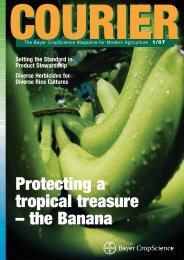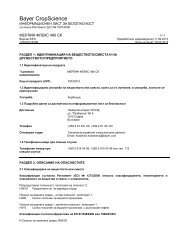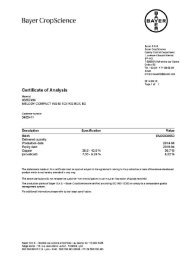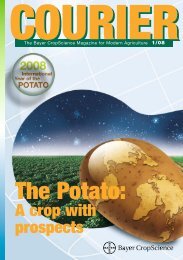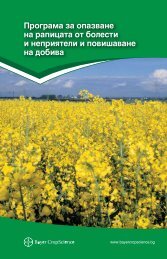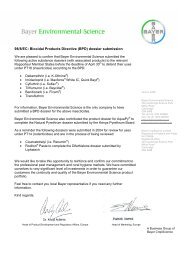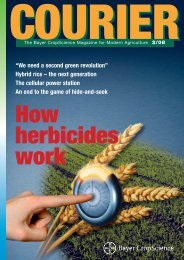For healthy potatoes - Bayer CropScience
For healthy potatoes - Bayer CropScience
For healthy potatoes - Bayer CropScience
You also want an ePaper? Increase the reach of your titles
YUMPU automatically turns print PDFs into web optimized ePapers that Google loves.
Birds-eye view of a trials field: the untreated plots can be clearly<br />
distinguished from the treated ones.<br />
A glance at the untreated plots shows the devastating effect of<br />
Phytophthora infestans on potato plants.<br />
After infection, the further development<br />
of the fungus is predominantly determined<br />
by climatic conditions. Sporangium formation<br />
requires high humidity, and has a temperature<br />
optimum in the range 18°-23°C.<br />
The sporangia are dispersed by wind. If a<br />
sporangium lands on a potato plant, 6-12<br />
zoospores can be released. This process<br />
can only occur in water droplets on the<br />
plant surface. The zoospores quickly germinate<br />
to form a germ-tube, which penetrates<br />
into the plant’s tissues. Under optimal<br />
conditions, a successful infection can<br />
usually occur within 2 hours. The infection<br />
process can take place on either side of the<br />
leaf.<br />
The incubation period, i.e. the period<br />
between penetration of the host and the<br />
first appearance of lesions, lasts 2-3 days.<br />
The infection cycle continues when the<br />
pathogen sporulates. Sporangia are<br />
released into dew or raindrops and can<br />
enter the upper soil layers when this water<br />
runs off the leaf. Here, they release their<br />
zoospores, which are able to penetrate into<br />
very young tubers through the epidermis.<br />
In older tubers, in contrast, the pathogen<br />
can only penetrate into the tuber’s starchy<br />
interior through open lenticels, via stomata,<br />
or through the eye. The pathogen has a<br />
further opportunity to infect tubers during<br />
the harvesting process, during which<br />
tubers come into contact with infected<br />
foliage or with earth contaminated with<br />
sporangia. Inoculum in the form of sporangia<br />
can remain viable in soil for some time<br />
(ca. 30 days). Even small injuries to tubers<br />
are sufficient to allow infection.<br />
Symptoms<br />
Because potato leaves tend to develop<br />
various brown spots during the vegetative<br />
period, it is important that advisors and<br />
farmers are able to identify late blight<br />
symptoms clearly.<br />
Primary infections are seen on the stem<br />
and the petioles (leaf-stalks). These plant<br />
parts become brown, and eventually nearly<br />
black, and the associated leaves die off.<br />
Surface growth of the fungus is rarely seen<br />
on stems.<br />
Initial symptoms of leaf infection are<br />
small, yellowish to dark-green spots.<br />
Infection usually first occurs on leaf margins<br />
and leaf tips, because this is where<br />
water droplets are retained longest. Under<br />
favourable environmental conditions, the<br />
spots quickly enlarge and become darkbrown<br />
to black. A whitish-grey zone of<br />
downy fungal growth can be seen on the<br />
underside of the leaf at the border between<br />
infected and <strong>healthy</strong> tissue. This is particularly<br />
obvious to the eye during periods of<br />
high air humidity, in the early morning<br />
(dew period) or after rainfall. The white<br />
zone is the unmistakable sign of late blight<br />
infection.<br />
Infected tubers have more-or-less large,<br />
irregular and slightly sunken, blue-grey<br />
spots on their surfaces. Below the areas<br />
showing these symptoms, large parts of the<br />
starchy tissues are discoloured rustybrown;<br />
there is no sharp distinction<br />
between the rusty-brown areas and <strong>healthy</strong><br />
tuber tissue.<br />
12 COURIER 2/06





